Strategic Development Tools: Analysis and Applications
VerifiedAdded on 2023/06/09
|13
|2975
|475
Report
AI Summary
This report delves into the realm of strategic development tools, essential for business success. It examines five key tools: SWOT analysis, PESTLE analysis, Five Forces analysis, the Resource-based View Model, and the Input-Output Model. Each tool is thoroughly explained, including a review of its underlying theory, a real-world case study illustrating its application, and a discussion of the opportunities and threats associated with its use. The report highlights how these tools aid organizations in organizing priorities, allocating resources, and adapting to environmental changes to achieve strategic goals and maintain a competitive edge. It explores the strengths, weaknesses, opportunities, and threats (SWOT) analysis, the political, economic, social, technological, legal, and environmental (PESTLE) analysis, and the competitive forces shaping industries. Furthermore, it discusses how companies can leverage their resources for competitive advantage and how nations can utilize economic models to track economic progress. The report concludes by emphasizing the importance of these tools and the need for continued research and education to facilitate their effective application.
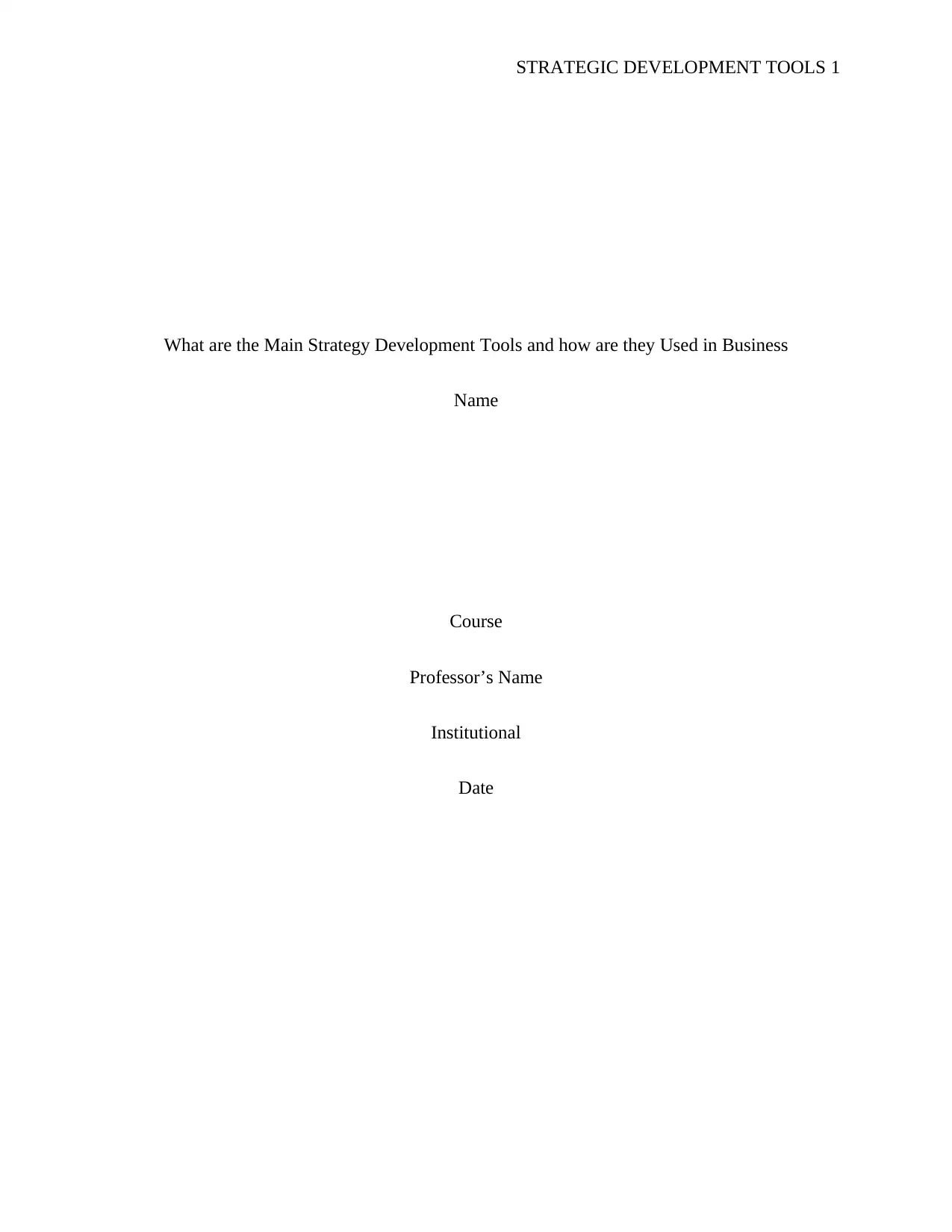
STRATEGIC DEVELOPMENT TOOLS 1
What are the Main Strategy Development Tools and how are they Used in Business
Name
Course
Professor’s Name
Institutional
Date
What are the Main Strategy Development Tools and how are they Used in Business
Name
Course
Professor’s Name
Institutional
Date
Paraphrase This Document
Need a fresh take? Get an instant paraphrase of this document with our AI Paraphraser
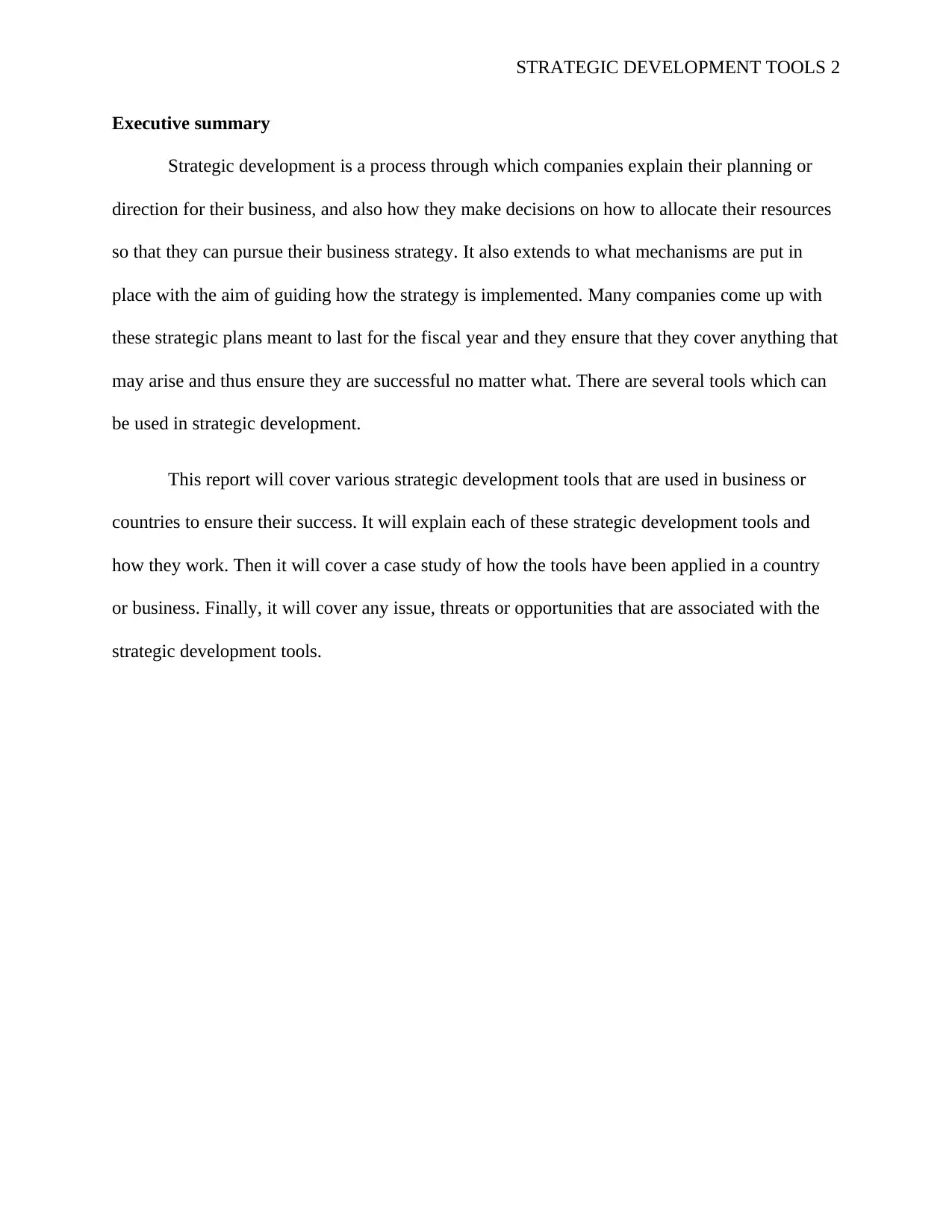
STRATEGIC DEVELOPMENT TOOLS 2
Executive summary
Strategic development is a process through which companies explain their planning or
direction for their business, and also how they make decisions on how to allocate their resources
so that they can pursue their business strategy. It also extends to what mechanisms are put in
place with the aim of guiding how the strategy is implemented. Many companies come up with
these strategic plans meant to last for the fiscal year and they ensure that they cover anything that
may arise and thus ensure they are successful no matter what. There are several tools which can
be used in strategic development.
This report will cover various strategic development tools that are used in business or
countries to ensure their success. It will explain each of these strategic development tools and
how they work. Then it will cover a case study of how the tools have been applied in a country
or business. Finally, it will cover any issue, threats or opportunities that are associated with the
strategic development tools.
Executive summary
Strategic development is a process through which companies explain their planning or
direction for their business, and also how they make decisions on how to allocate their resources
so that they can pursue their business strategy. It also extends to what mechanisms are put in
place with the aim of guiding how the strategy is implemented. Many companies come up with
these strategic plans meant to last for the fiscal year and they ensure that they cover anything that
may arise and thus ensure they are successful no matter what. There are several tools which can
be used in strategic development.
This report will cover various strategic development tools that are used in business or
countries to ensure their success. It will explain each of these strategic development tools and
how they work. Then it will cover a case study of how the tools have been applied in a country
or business. Finally, it will cover any issue, threats or opportunities that are associated with the
strategic development tools.
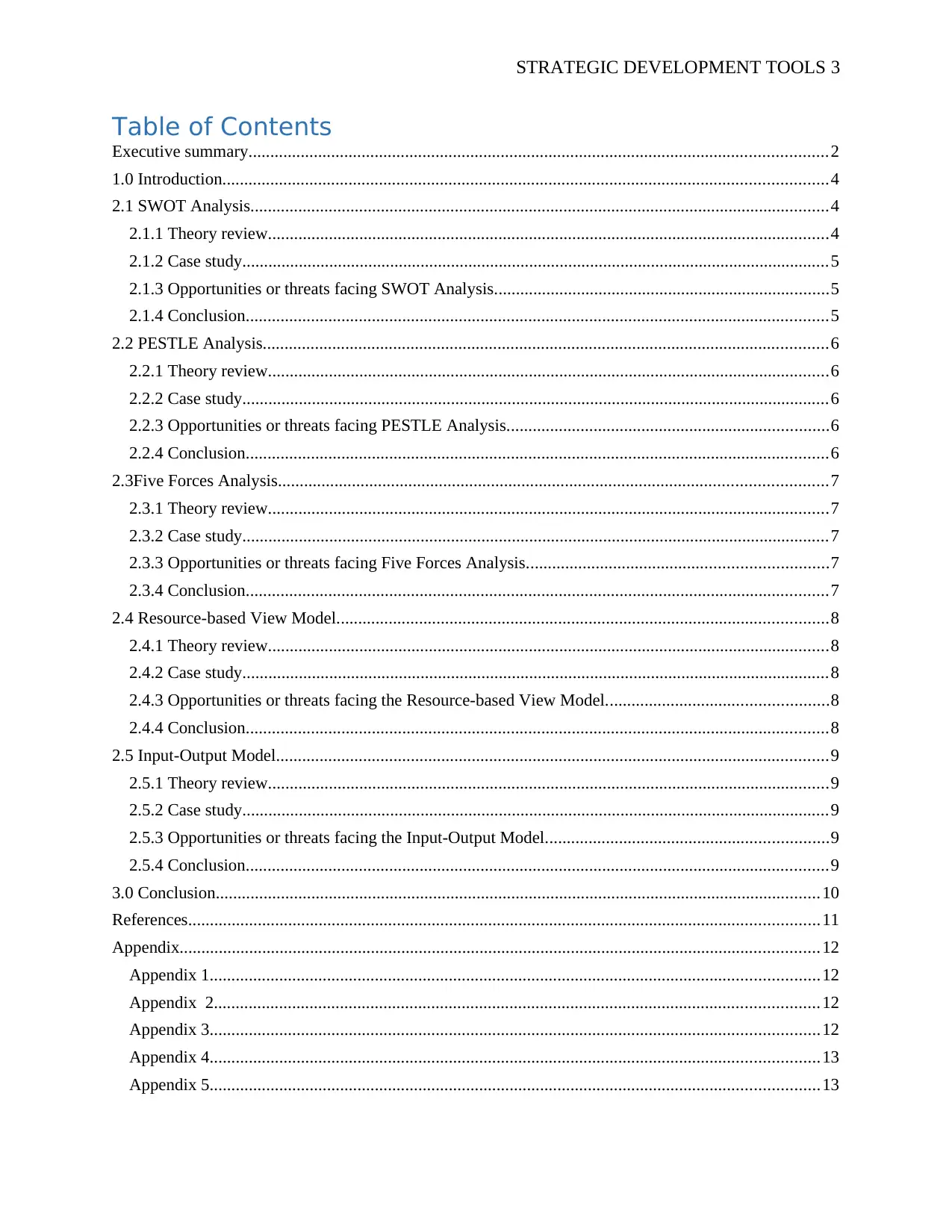
STRATEGIC DEVELOPMENT TOOLS 3
Table of Contents
Executive summary.....................................................................................................................................2
1.0 Introduction...........................................................................................................................................4
2.1 SWOT Analysis.....................................................................................................................................4
2.1.1 Theory review.................................................................................................................................4
2.1.2 Case study.......................................................................................................................................5
2.1.3 Opportunities or threats facing SWOT Analysis.............................................................................5
2.1.4 Conclusion......................................................................................................................................5
2.2 PESTLE Analysis..................................................................................................................................6
2.2.1 Theory review.................................................................................................................................6
2.2.2 Case study.......................................................................................................................................6
2.2.3 Opportunities or threats facing PESTLE Analysis..........................................................................6
2.2.4 Conclusion......................................................................................................................................6
2.3Five Forces Analysis..............................................................................................................................7
2.3.1 Theory review.................................................................................................................................7
2.3.2 Case study.......................................................................................................................................7
2.3.3 Opportunities or threats facing Five Forces Analysis.....................................................................7
2.3.4 Conclusion......................................................................................................................................7
2.4 Resource-based View Model.................................................................................................................8
2.4.1 Theory review.................................................................................................................................8
2.4.2 Case study.......................................................................................................................................8
2.4.3 Opportunities or threats facing the Resource-based View Model...................................................8
2.4.4 Conclusion......................................................................................................................................8
2.5 Input-Output Model...............................................................................................................................9
2.5.1 Theory review.................................................................................................................................9
2.5.2 Case study.......................................................................................................................................9
2.5.3 Opportunities or threats facing the Input-Output Model.................................................................9
2.5.4 Conclusion......................................................................................................................................9
3.0 Conclusion...........................................................................................................................................10
References.................................................................................................................................................11
Appendix...................................................................................................................................................12
Appendix 1............................................................................................................................................12
Appendix 2...........................................................................................................................................12
Appendix 3............................................................................................................................................12
Appendix 4............................................................................................................................................13
Appendix 5............................................................................................................................................13
Table of Contents
Executive summary.....................................................................................................................................2
1.0 Introduction...........................................................................................................................................4
2.1 SWOT Analysis.....................................................................................................................................4
2.1.1 Theory review.................................................................................................................................4
2.1.2 Case study.......................................................................................................................................5
2.1.3 Opportunities or threats facing SWOT Analysis.............................................................................5
2.1.4 Conclusion......................................................................................................................................5
2.2 PESTLE Analysis..................................................................................................................................6
2.2.1 Theory review.................................................................................................................................6
2.2.2 Case study.......................................................................................................................................6
2.2.3 Opportunities or threats facing PESTLE Analysis..........................................................................6
2.2.4 Conclusion......................................................................................................................................6
2.3Five Forces Analysis..............................................................................................................................7
2.3.1 Theory review.................................................................................................................................7
2.3.2 Case study.......................................................................................................................................7
2.3.3 Opportunities or threats facing Five Forces Analysis.....................................................................7
2.3.4 Conclusion......................................................................................................................................7
2.4 Resource-based View Model.................................................................................................................8
2.4.1 Theory review.................................................................................................................................8
2.4.2 Case study.......................................................................................................................................8
2.4.3 Opportunities or threats facing the Resource-based View Model...................................................8
2.4.4 Conclusion......................................................................................................................................8
2.5 Input-Output Model...............................................................................................................................9
2.5.1 Theory review.................................................................................................................................9
2.5.2 Case study.......................................................................................................................................9
2.5.3 Opportunities or threats facing the Input-Output Model.................................................................9
2.5.4 Conclusion......................................................................................................................................9
3.0 Conclusion...........................................................................................................................................10
References.................................................................................................................................................11
Appendix...................................................................................................................................................12
Appendix 1............................................................................................................................................12
Appendix 2...........................................................................................................................................12
Appendix 3............................................................................................................................................12
Appendix 4............................................................................................................................................13
Appendix 5............................................................................................................................................13
⊘ This is a preview!⊘
Do you want full access?
Subscribe today to unlock all pages.

Trusted by 1+ million students worldwide
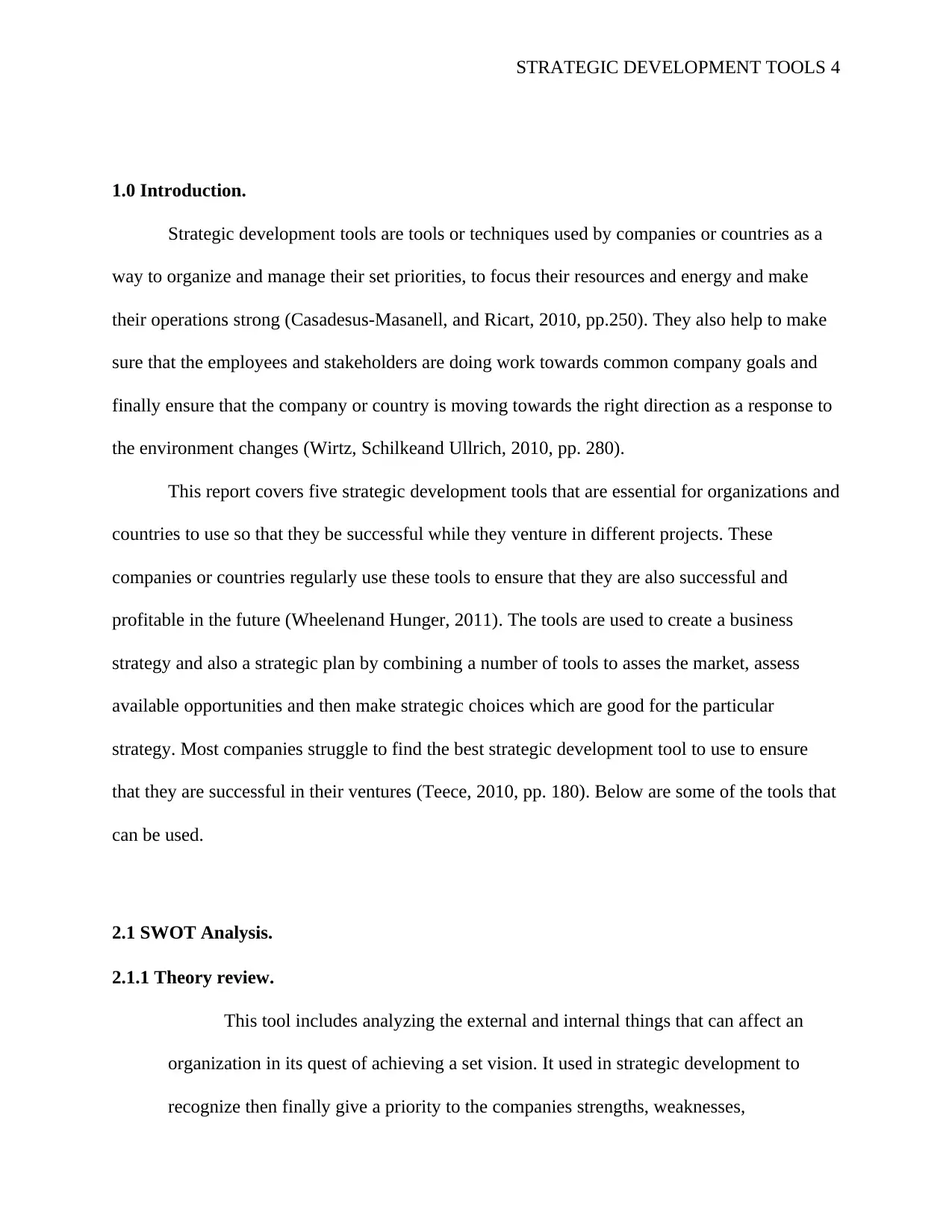
STRATEGIC DEVELOPMENT TOOLS 4
1.0 Introduction.
Strategic development tools are tools or techniques used by companies or countries as a
way to organize and manage their set priorities, to focus their resources and energy and make
their operations strong (Casadesus-Masanell, and Ricart, 2010, pp.250). They also help to make
sure that the employees and stakeholders are doing work towards common company goals and
finally ensure that the company or country is moving towards the right direction as a response to
the environment changes (Wirtz, Schilkeand Ullrich, 2010, pp. 280).
This report covers five strategic development tools that are essential for organizations and
countries to use so that they be successful while they venture in different projects. These
companies or countries regularly use these tools to ensure that they are also successful and
profitable in the future (Wheelenand Hunger, 2011). The tools are used to create a business
strategy and also a strategic plan by combining a number of tools to asses the market, assess
available opportunities and then make strategic choices which are good for the particular
strategy. Most companies struggle to find the best strategic development tool to use to ensure
that they are successful in their ventures (Teece, 2010, pp. 180). Below are some of the tools that
can be used.
2.1 SWOT Analysis.
2.1.1 Theory review.
This tool includes analyzing the external and internal things that can affect an
organization in its quest of achieving a set vision. It used in strategic development to
recognize then finally give a priority to the companies strengths, weaknesses,
1.0 Introduction.
Strategic development tools are tools or techniques used by companies or countries as a
way to organize and manage their set priorities, to focus their resources and energy and make
their operations strong (Casadesus-Masanell, and Ricart, 2010, pp.250). They also help to make
sure that the employees and stakeholders are doing work towards common company goals and
finally ensure that the company or country is moving towards the right direction as a response to
the environment changes (Wirtz, Schilkeand Ullrich, 2010, pp. 280).
This report covers five strategic development tools that are essential for organizations and
countries to use so that they be successful while they venture in different projects. These
companies or countries regularly use these tools to ensure that they are also successful and
profitable in the future (Wheelenand Hunger, 2011). The tools are used to create a business
strategy and also a strategic plan by combining a number of tools to asses the market, assess
available opportunities and then make strategic choices which are good for the particular
strategy. Most companies struggle to find the best strategic development tool to use to ensure
that they are successful in their ventures (Teece, 2010, pp. 180). Below are some of the tools that
can be used.
2.1 SWOT Analysis.
2.1.1 Theory review.
This tool includes analyzing the external and internal things that can affect an
organization in its quest of achieving a set vision. It used in strategic development to
recognize then finally give a priority to the companies strengths, weaknesses,
Paraphrase This Document
Need a fresh take? Get an instant paraphrase of this document with our AI Paraphraser
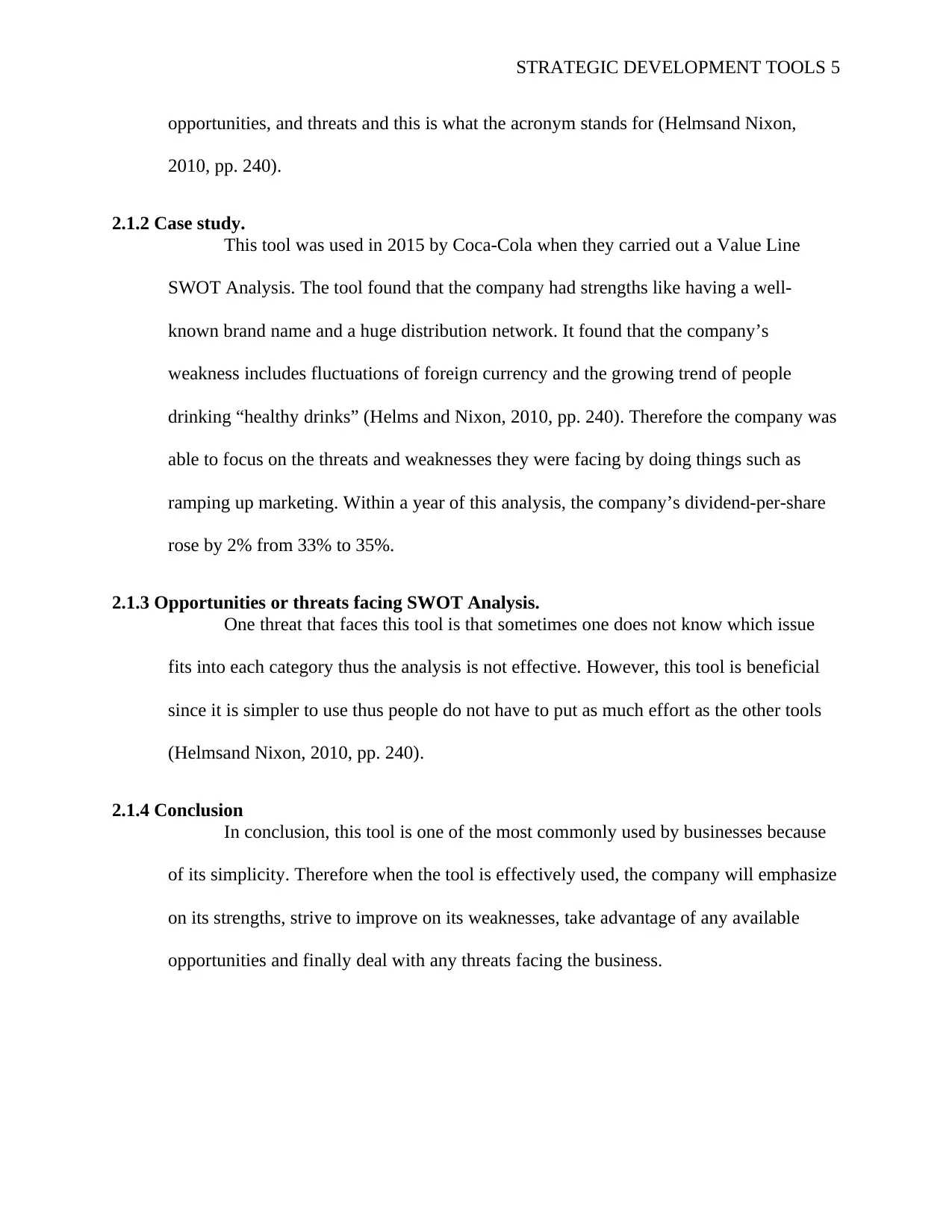
STRATEGIC DEVELOPMENT TOOLS 5
opportunities, and threats and this is what the acronym stands for (Helmsand Nixon,
2010, pp. 240).
2.1.2 Case study.
This tool was used in 2015 by Coca-Cola when they carried out a Value Line
SWOT Analysis. The tool found that the company had strengths like having a well-
known brand name and a huge distribution network. It found that the company’s
weakness includes fluctuations of foreign currency and the growing trend of people
drinking “healthy drinks” (Helms and Nixon, 2010, pp. 240). Therefore the company was
able to focus on the threats and weaknesses they were facing by doing things such as
ramping up marketing. Within a year of this analysis, the company’s dividend-per-share
rose by 2% from 33% to 35%.
2.1.3 Opportunities or threats facing SWOT Analysis.
One threat that faces this tool is that sometimes one does not know which issue
fits into each category thus the analysis is not effective. However, this tool is beneficial
since it is simpler to use thus people do not have to put as much effort as the other tools
(Helmsand Nixon, 2010, pp. 240).
2.1.4 Conclusion
In conclusion, this tool is one of the most commonly used by businesses because
of its simplicity. Therefore when the tool is effectively used, the company will emphasize
on its strengths, strive to improve on its weaknesses, take advantage of any available
opportunities and finally deal with any threats facing the business.
opportunities, and threats and this is what the acronym stands for (Helmsand Nixon,
2010, pp. 240).
2.1.2 Case study.
This tool was used in 2015 by Coca-Cola when they carried out a Value Line
SWOT Analysis. The tool found that the company had strengths like having a well-
known brand name and a huge distribution network. It found that the company’s
weakness includes fluctuations of foreign currency and the growing trend of people
drinking “healthy drinks” (Helms and Nixon, 2010, pp. 240). Therefore the company was
able to focus on the threats and weaknesses they were facing by doing things such as
ramping up marketing. Within a year of this analysis, the company’s dividend-per-share
rose by 2% from 33% to 35%.
2.1.3 Opportunities or threats facing SWOT Analysis.
One threat that faces this tool is that sometimes one does not know which issue
fits into each category thus the analysis is not effective. However, this tool is beneficial
since it is simpler to use thus people do not have to put as much effort as the other tools
(Helmsand Nixon, 2010, pp. 240).
2.1.4 Conclusion
In conclusion, this tool is one of the most commonly used by businesses because
of its simplicity. Therefore when the tool is effectively used, the company will emphasize
on its strengths, strive to improve on its weaknesses, take advantage of any available
opportunities and finally deal with any threats facing the business.
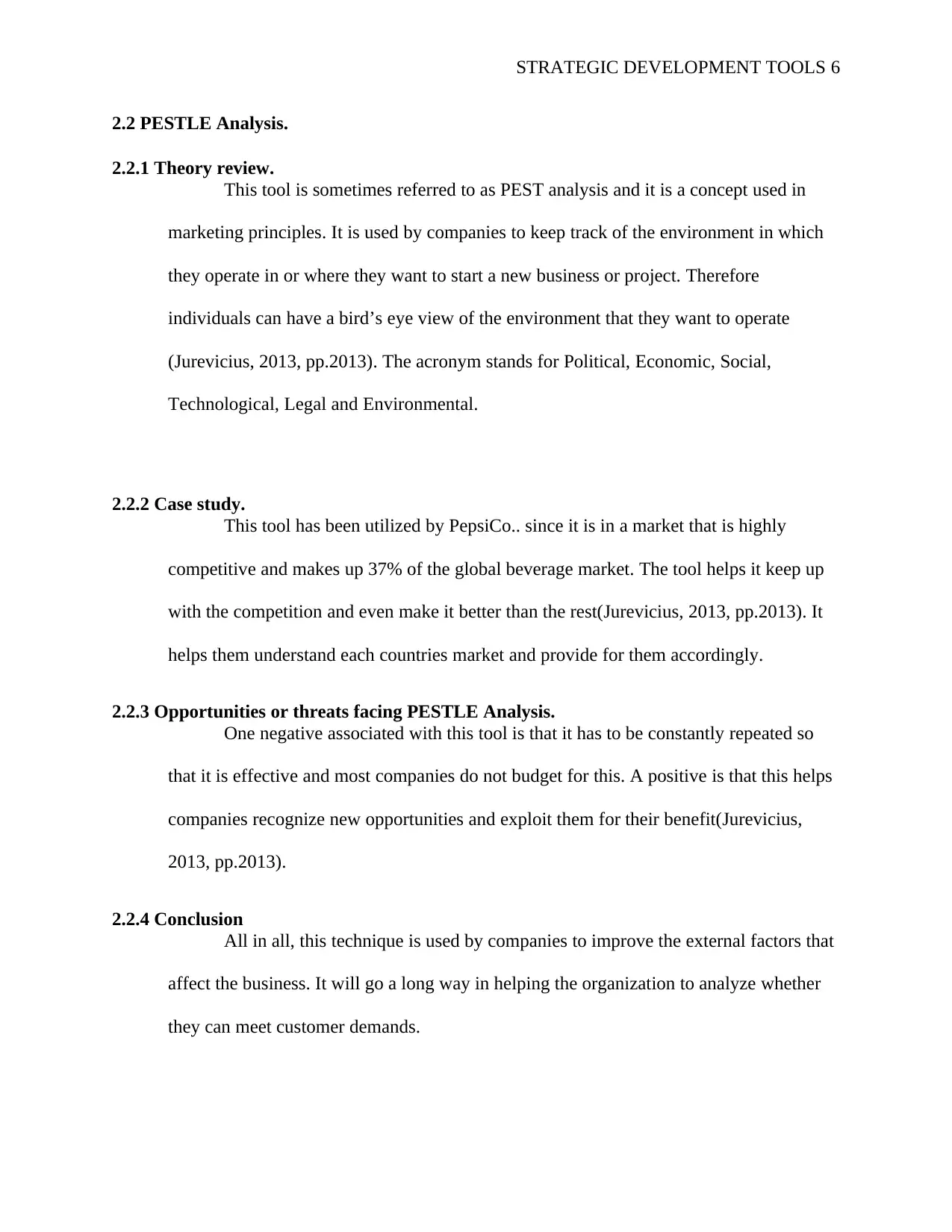
STRATEGIC DEVELOPMENT TOOLS 6
2.2 PESTLE Analysis.
2.2.1 Theory review.
This tool is sometimes referred to as PEST analysis and it is a concept used in
marketing principles. It is used by companies to keep track of the environment in which
they operate in or where they want to start a new business or project. Therefore
individuals can have a bird’s eye view of the environment that they want to operate
(Jurevicius, 2013, pp.2013). The acronym stands for Political, Economic, Social,
Technological, Legal and Environmental.
2.2.2 Case study.
This tool has been utilized by PepsiCo.. since it is in a market that is highly
competitive and makes up 37% of the global beverage market. The tool helps it keep up
with the competition and even make it better than the rest(Jurevicius, 2013, pp.2013). It
helps them understand each countries market and provide for them accordingly.
2.2.3 Opportunities or threats facing PESTLE Analysis.
One negative associated with this tool is that it has to be constantly repeated so
that it is effective and most companies do not budget for this. A positive is that this helps
companies recognize new opportunities and exploit them for their benefit(Jurevicius,
2013, pp.2013).
2.2.4 Conclusion
All in all, this technique is used by companies to improve the external factors that
affect the business. It will go a long way in helping the organization to analyze whether
they can meet customer demands.
2.2 PESTLE Analysis.
2.2.1 Theory review.
This tool is sometimes referred to as PEST analysis and it is a concept used in
marketing principles. It is used by companies to keep track of the environment in which
they operate in or where they want to start a new business or project. Therefore
individuals can have a bird’s eye view of the environment that they want to operate
(Jurevicius, 2013, pp.2013). The acronym stands for Political, Economic, Social,
Technological, Legal and Environmental.
2.2.2 Case study.
This tool has been utilized by PepsiCo.. since it is in a market that is highly
competitive and makes up 37% of the global beverage market. The tool helps it keep up
with the competition and even make it better than the rest(Jurevicius, 2013, pp.2013). It
helps them understand each countries market and provide for them accordingly.
2.2.3 Opportunities or threats facing PESTLE Analysis.
One negative associated with this tool is that it has to be constantly repeated so
that it is effective and most companies do not budget for this. A positive is that this helps
companies recognize new opportunities and exploit them for their benefit(Jurevicius,
2013, pp.2013).
2.2.4 Conclusion
All in all, this technique is used by companies to improve the external factors that
affect the business. It will go a long way in helping the organization to analyze whether
they can meet customer demands.
⊘ This is a preview!⊘
Do you want full access?
Subscribe today to unlock all pages.

Trusted by 1+ million students worldwide
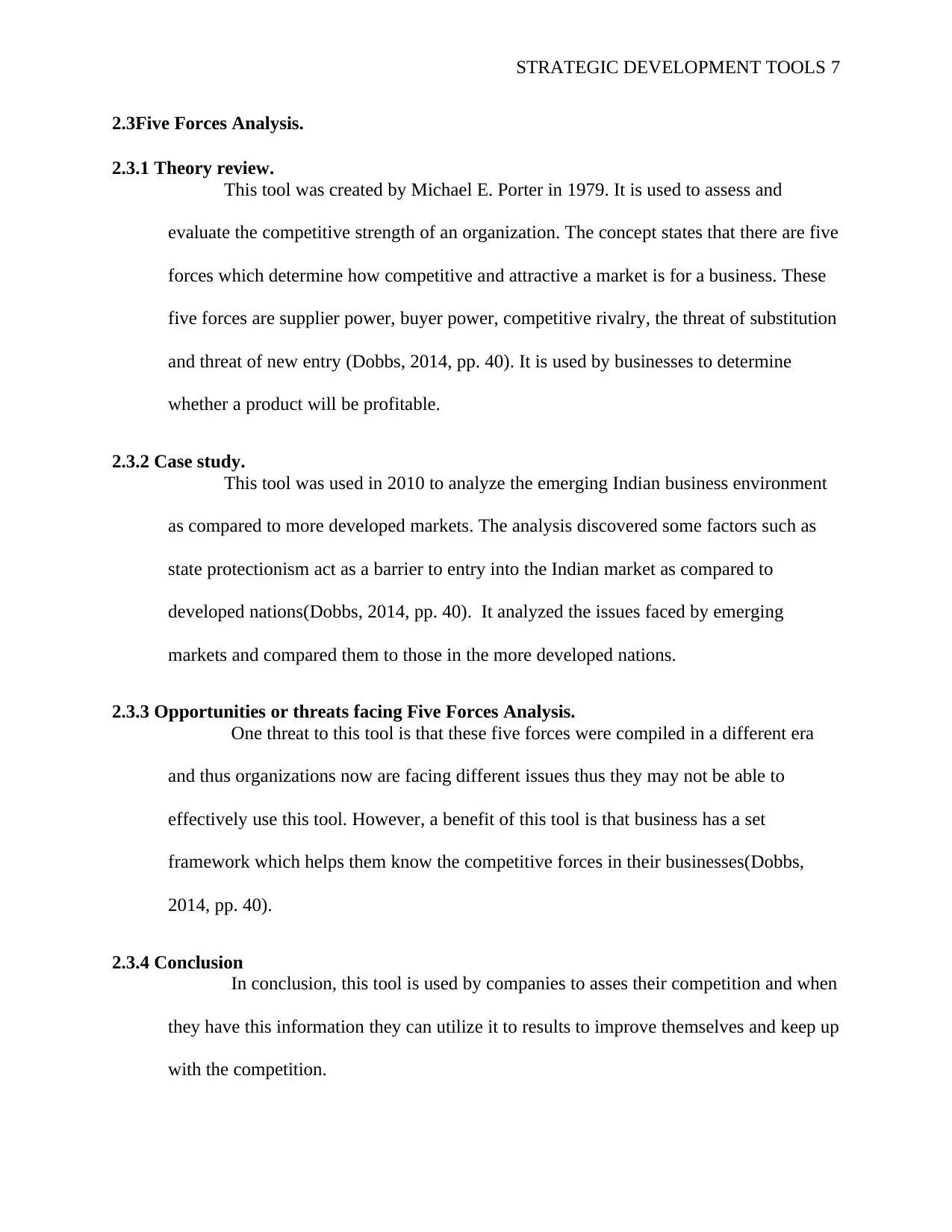
STRATEGIC DEVELOPMENT TOOLS 7
2.3Five Forces Analysis.
2.3.1 Theory review.
This tool was created by Michael E. Porter in 1979. It is used to assess and
evaluate the competitive strength of an organization. The concept states that there are five
forces which determine how competitive and attractive a market is for a business. These
five forces are supplier power, buyer power, competitive rivalry, the threat of substitution
and threat of new entry (Dobbs, 2014, pp. 40). It is used by businesses to determine
whether a product will be profitable.
2.3.2 Case study.
This tool was used in 2010 to analyze the emerging Indian business environment
as compared to more developed markets. The analysis discovered some factors such as
state protectionism act as a barrier to entry into the Indian market as compared to
developed nations(Dobbs, 2014, pp. 40). It analyzed the issues faced by emerging
markets and compared them to those in the more developed nations.
2.3.3 Opportunities or threats facing Five Forces Analysis.
One threat to this tool is that these five forces were compiled in a different era
and thus organizations now are facing different issues thus they may not be able to
effectively use this tool. However, a benefit of this tool is that business has a set
framework which helps them know the competitive forces in their businesses(Dobbs,
2014, pp. 40).
2.3.4 Conclusion
In conclusion, this tool is used by companies to asses their competition and when
they have this information they can utilize it to results to improve themselves and keep up
with the competition.
2.3Five Forces Analysis.
2.3.1 Theory review.
This tool was created by Michael E. Porter in 1979. It is used to assess and
evaluate the competitive strength of an organization. The concept states that there are five
forces which determine how competitive and attractive a market is for a business. These
five forces are supplier power, buyer power, competitive rivalry, the threat of substitution
and threat of new entry (Dobbs, 2014, pp. 40). It is used by businesses to determine
whether a product will be profitable.
2.3.2 Case study.
This tool was used in 2010 to analyze the emerging Indian business environment
as compared to more developed markets. The analysis discovered some factors such as
state protectionism act as a barrier to entry into the Indian market as compared to
developed nations(Dobbs, 2014, pp. 40). It analyzed the issues faced by emerging
markets and compared them to those in the more developed nations.
2.3.3 Opportunities or threats facing Five Forces Analysis.
One threat to this tool is that these five forces were compiled in a different era
and thus organizations now are facing different issues thus they may not be able to
effectively use this tool. However, a benefit of this tool is that business has a set
framework which helps them know the competitive forces in their businesses(Dobbs,
2014, pp. 40).
2.3.4 Conclusion
In conclusion, this tool is used by companies to asses their competition and when
they have this information they can utilize it to results to improve themselves and keep up
with the competition.
Paraphrase This Document
Need a fresh take? Get an instant paraphrase of this document with our AI Paraphraser
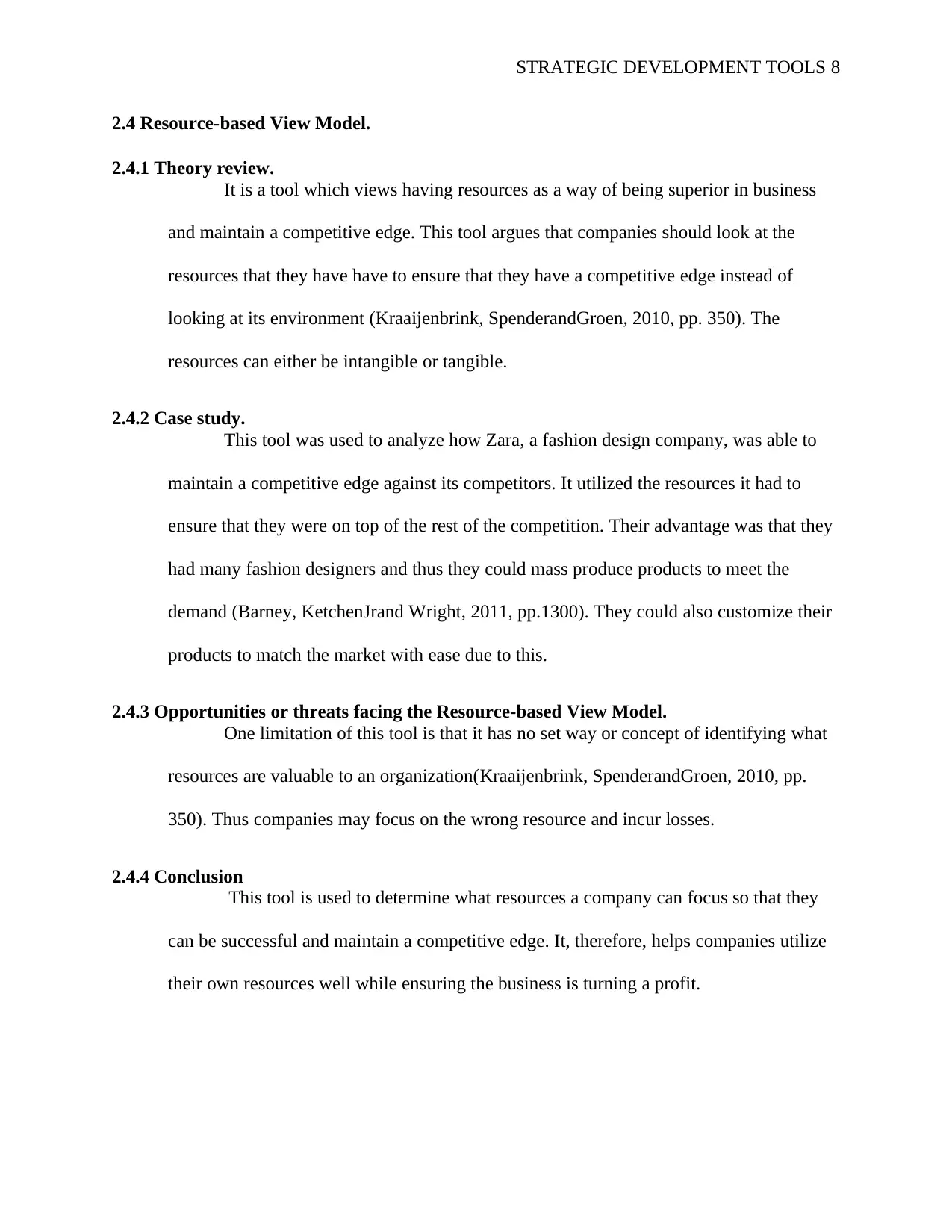
STRATEGIC DEVELOPMENT TOOLS 8
2.4 Resource-based View Model.
2.4.1 Theory review.
It is a tool which views having resources as a way of being superior in business
and maintain a competitive edge. This tool argues that companies should look at the
resources that they have have to ensure that they have a competitive edge instead of
looking at its environment (Kraaijenbrink, SpenderandGroen, 2010, pp. 350). The
resources can either be intangible or tangible.
2.4.2 Case study.
This tool was used to analyze how Zara, a fashion design company, was able to
maintain a competitive edge against its competitors. It utilized the resources it had to
ensure that they were on top of the rest of the competition. Their advantage was that they
had many fashion designers and thus they could mass produce products to meet the
demand (Barney, KetchenJrand Wright, 2011, pp.1300). They could also customize their
products to match the market with ease due to this.
2.4.3 Opportunities or threats facing the Resource-based View Model.
One limitation of this tool is that it has no set way or concept of identifying what
resources are valuable to an organization(Kraaijenbrink, SpenderandGroen, 2010, pp.
350). Thus companies may focus on the wrong resource and incur losses.
2.4.4 Conclusion
This tool is used to determine what resources a company can focus so that they
can be successful and maintain a competitive edge. It, therefore, helps companies utilize
their own resources well while ensuring the business is turning a profit.
2.4 Resource-based View Model.
2.4.1 Theory review.
It is a tool which views having resources as a way of being superior in business
and maintain a competitive edge. This tool argues that companies should look at the
resources that they have have to ensure that they have a competitive edge instead of
looking at its environment (Kraaijenbrink, SpenderandGroen, 2010, pp. 350). The
resources can either be intangible or tangible.
2.4.2 Case study.
This tool was used to analyze how Zara, a fashion design company, was able to
maintain a competitive edge against its competitors. It utilized the resources it had to
ensure that they were on top of the rest of the competition. Their advantage was that they
had many fashion designers and thus they could mass produce products to meet the
demand (Barney, KetchenJrand Wright, 2011, pp.1300). They could also customize their
products to match the market with ease due to this.
2.4.3 Opportunities or threats facing the Resource-based View Model.
One limitation of this tool is that it has no set way or concept of identifying what
resources are valuable to an organization(Kraaijenbrink, SpenderandGroen, 2010, pp.
350). Thus companies may focus on the wrong resource and incur losses.
2.4.4 Conclusion
This tool is used to determine what resources a company can focus so that they
can be successful and maintain a competitive edge. It, therefore, helps companies utilize
their own resources well while ensuring the business is turning a profit.
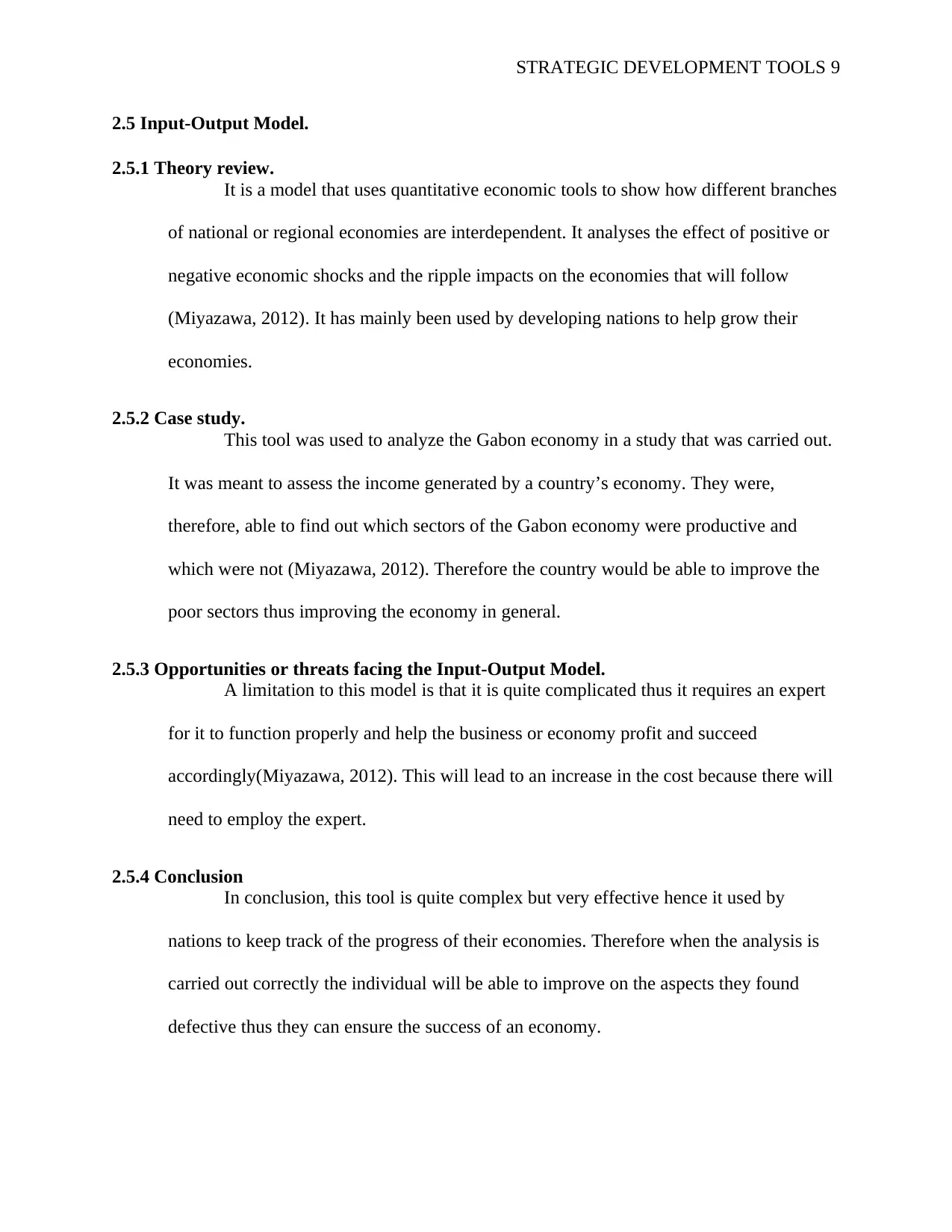
STRATEGIC DEVELOPMENT TOOLS 9
2.5 Input-Output Model.
2.5.1 Theory review.
It is a model that uses quantitative economic tools to show how different branches
of national or regional economies are interdependent. It analyses the effect of positive or
negative economic shocks and the ripple impacts on the economies that will follow
(Miyazawa, 2012). It has mainly been used by developing nations to help grow their
economies.
2.5.2 Case study.
This tool was used to analyze the Gabon economy in a study that was carried out.
It was meant to assess the income generated by a country’s economy. They were,
therefore, able to find out which sectors of the Gabon economy were productive and
which were not (Miyazawa, 2012). Therefore the country would be able to improve the
poor sectors thus improving the economy in general.
2.5.3 Opportunities or threats facing the Input-Output Model.
A limitation to this model is that it is quite complicated thus it requires an expert
for it to function properly and help the business or economy profit and succeed
accordingly(Miyazawa, 2012). This will lead to an increase in the cost because there will
need to employ the expert.
2.5.4 Conclusion
In conclusion, this tool is quite complex but very effective hence it used by
nations to keep track of the progress of their economies. Therefore when the analysis is
carried out correctly the individual will be able to improve on the aspects they found
defective thus they can ensure the success of an economy.
2.5 Input-Output Model.
2.5.1 Theory review.
It is a model that uses quantitative economic tools to show how different branches
of national or regional economies are interdependent. It analyses the effect of positive or
negative economic shocks and the ripple impacts on the economies that will follow
(Miyazawa, 2012). It has mainly been used by developing nations to help grow their
economies.
2.5.2 Case study.
This tool was used to analyze the Gabon economy in a study that was carried out.
It was meant to assess the income generated by a country’s economy. They were,
therefore, able to find out which sectors of the Gabon economy were productive and
which were not (Miyazawa, 2012). Therefore the country would be able to improve the
poor sectors thus improving the economy in general.
2.5.3 Opportunities or threats facing the Input-Output Model.
A limitation to this model is that it is quite complicated thus it requires an expert
for it to function properly and help the business or economy profit and succeed
accordingly(Miyazawa, 2012). This will lead to an increase in the cost because there will
need to employ the expert.
2.5.4 Conclusion
In conclusion, this tool is quite complex but very effective hence it used by
nations to keep track of the progress of their economies. Therefore when the analysis is
carried out correctly the individual will be able to improve on the aspects they found
defective thus they can ensure the success of an economy.
⊘ This is a preview!⊘
Do you want full access?
Subscribe today to unlock all pages.

Trusted by 1+ million students worldwide

STRATEGIC DEVELOPMENT TOOLS 10
3.0 Conclusion
All in all, strategic development tools are important methods which countries and
companies can use to improve themselves, ensure their success and in the end lead to profits.
There are several strategic development tools however in this report five we covered. These five
were analyzed in depth, case studies gave showing them in action and finally, benefits and
threats to them were given. These tools are quite important thus more studies need to be carried
out on this matter so that everyone can benefit from the results. Most people find it hard to
choose the right tool to use for them since there are many options in place, therefore people
should be educated about them so that it will be easier to choose.
3.0 Conclusion
All in all, strategic development tools are important methods which countries and
companies can use to improve themselves, ensure their success and in the end lead to profits.
There are several strategic development tools however in this report five we covered. These five
were analyzed in depth, case studies gave showing them in action and finally, benefits and
threats to them were given. These tools are quite important thus more studies need to be carried
out on this matter so that everyone can benefit from the results. Most people find it hard to
choose the right tool to use for them since there are many options in place, therefore people
should be educated about them so that it will be easier to choose.
Paraphrase This Document
Need a fresh take? Get an instant paraphrase of this document with our AI Paraphraser
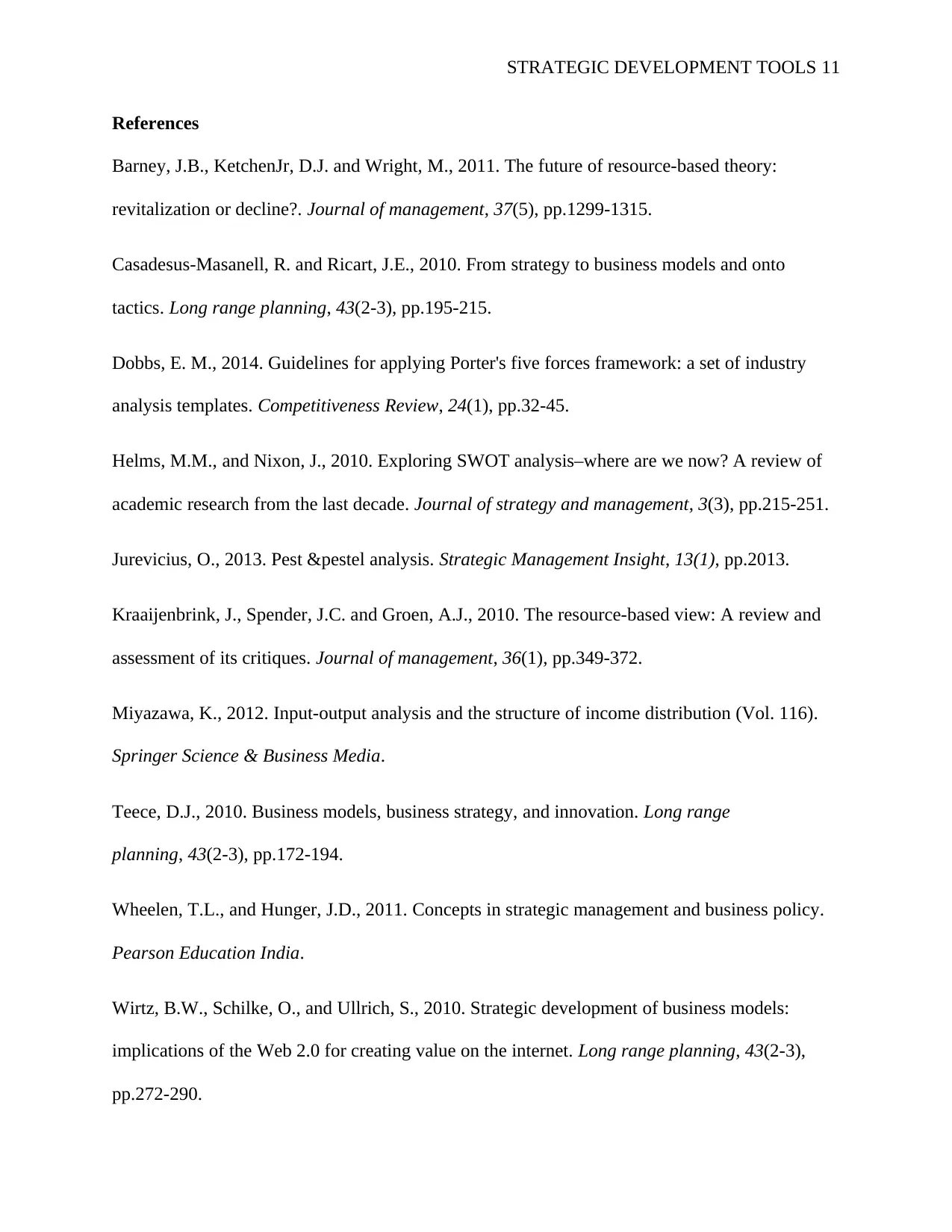
STRATEGIC DEVELOPMENT TOOLS 11
References
Barney, J.B., KetchenJr, D.J. and Wright, M., 2011. The future of resource-based theory:
revitalization or decline?. Journal of management, 37(5), pp.1299-1315.
Casadesus-Masanell, R. and Ricart, J.E., 2010. From strategy to business models and onto
tactics. Long range planning, 43(2-3), pp.195-215.
Dobbs, E. M., 2014. Guidelines for applying Porter's five forces framework: a set of industry
analysis templates. Competitiveness Review, 24(1), pp.32-45.
Helms, M.M., and Nixon, J., 2010. Exploring SWOT analysis–where are we now? A review of
academic research from the last decade. Journal of strategy and management, 3(3), pp.215-251.
Jurevicius, O., 2013. Pest &pestel analysis. Strategic Management Insight, 13(1), pp.2013.
Kraaijenbrink, J., Spender, J.C. and Groen, A.J., 2010. The resource-based view: A review and
assessment of its critiques. Journal of management, 36(1), pp.349-372.
Miyazawa, K., 2012. Input-output analysis and the structure of income distribution (Vol. 116).
Springer Science & Business Media.
Teece, D.J., 2010. Business models, business strategy, and innovation. Long range
planning, 43(2-3), pp.172-194.
Wheelen, T.L., and Hunger, J.D., 2011. Concepts in strategic management and business policy.
Pearson Education India.
Wirtz, B.W., Schilke, O., and Ullrich, S., 2010. Strategic development of business models:
implications of the Web 2.0 for creating value on the internet. Long range planning, 43(2-3),
pp.272-290.
References
Barney, J.B., KetchenJr, D.J. and Wright, M., 2011. The future of resource-based theory:
revitalization or decline?. Journal of management, 37(5), pp.1299-1315.
Casadesus-Masanell, R. and Ricart, J.E., 2010. From strategy to business models and onto
tactics. Long range planning, 43(2-3), pp.195-215.
Dobbs, E. M., 2014. Guidelines for applying Porter's five forces framework: a set of industry
analysis templates. Competitiveness Review, 24(1), pp.32-45.
Helms, M.M., and Nixon, J., 2010. Exploring SWOT analysis–where are we now? A review of
academic research from the last decade. Journal of strategy and management, 3(3), pp.215-251.
Jurevicius, O., 2013. Pest &pestel analysis. Strategic Management Insight, 13(1), pp.2013.
Kraaijenbrink, J., Spender, J.C. and Groen, A.J., 2010. The resource-based view: A review and
assessment of its critiques. Journal of management, 36(1), pp.349-372.
Miyazawa, K., 2012. Input-output analysis and the structure of income distribution (Vol. 116).
Springer Science & Business Media.
Teece, D.J., 2010. Business models, business strategy, and innovation. Long range
planning, 43(2-3), pp.172-194.
Wheelen, T.L., and Hunger, J.D., 2011. Concepts in strategic management and business policy.
Pearson Education India.
Wirtz, B.W., Schilke, O., and Ullrich, S., 2010. Strategic development of business models:
implications of the Web 2.0 for creating value on the internet. Long range planning, 43(2-3),
pp.272-290.
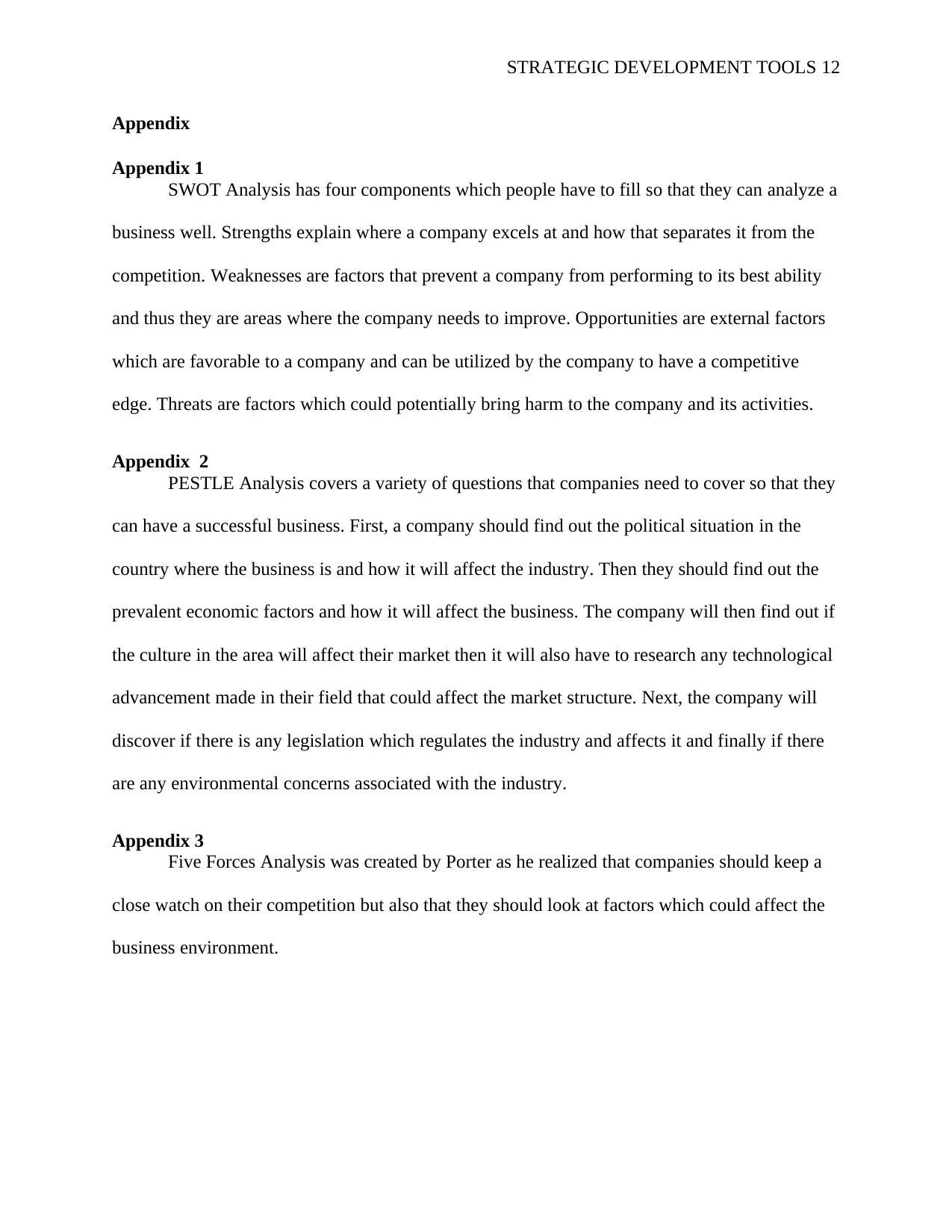
STRATEGIC DEVELOPMENT TOOLS 12
Appendix
Appendix 1
SWOT Analysis has four components which people have to fill so that they can analyze a
business well. Strengths explain where a company excels at and how that separates it from the
competition. Weaknesses are factors that prevent a company from performing to its best ability
and thus they are areas where the company needs to improve. Opportunities are external factors
which are favorable to a company and can be utilized by the company to have a competitive
edge. Threats are factors which could potentially bring harm to the company and its activities.
Appendix 2
PESTLE Analysis covers a variety of questions that companies need to cover so that they
can have a successful business. First, a company should find out the political situation in the
country where the business is and how it will affect the industry. Then they should find out the
prevalent economic factors and how it will affect the business. The company will then find out if
the culture in the area will affect their market then it will also have to research any technological
advancement made in their field that could affect the market structure. Next, the company will
discover if there is any legislation which regulates the industry and affects it and finally if there
are any environmental concerns associated with the industry.
Appendix 3
Five Forces Analysis was created by Porter as he realized that companies should keep a
close watch on their competition but also that they should look at factors which could affect the
business environment.
Appendix
Appendix 1
SWOT Analysis has four components which people have to fill so that they can analyze a
business well. Strengths explain where a company excels at and how that separates it from the
competition. Weaknesses are factors that prevent a company from performing to its best ability
and thus they are areas where the company needs to improve. Opportunities are external factors
which are favorable to a company and can be utilized by the company to have a competitive
edge. Threats are factors which could potentially bring harm to the company and its activities.
Appendix 2
PESTLE Analysis covers a variety of questions that companies need to cover so that they
can have a successful business. First, a company should find out the political situation in the
country where the business is and how it will affect the industry. Then they should find out the
prevalent economic factors and how it will affect the business. The company will then find out if
the culture in the area will affect their market then it will also have to research any technological
advancement made in their field that could affect the market structure. Next, the company will
discover if there is any legislation which regulates the industry and affects it and finally if there
are any environmental concerns associated with the industry.
Appendix 3
Five Forces Analysis was created by Porter as he realized that companies should keep a
close watch on their competition but also that they should look at factors which could affect the
business environment.
⊘ This is a preview!⊘
Do you want full access?
Subscribe today to unlock all pages.

Trusted by 1+ million students worldwide
1 out of 13
Related Documents
Your All-in-One AI-Powered Toolkit for Academic Success.
+13062052269
info@desklib.com
Available 24*7 on WhatsApp / Email
![[object Object]](/_next/static/media/star-bottom.7253800d.svg)
Unlock your academic potential
Copyright © 2020–2025 A2Z Services. All Rights Reserved. Developed and managed by ZUCOL.





